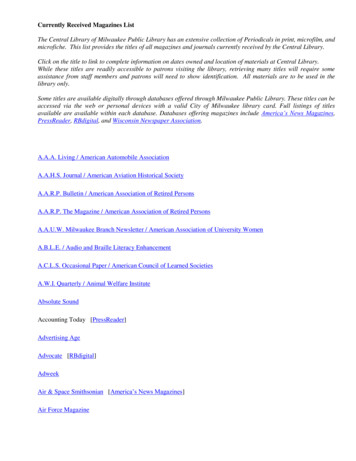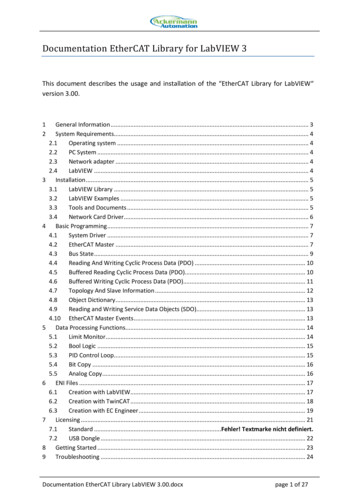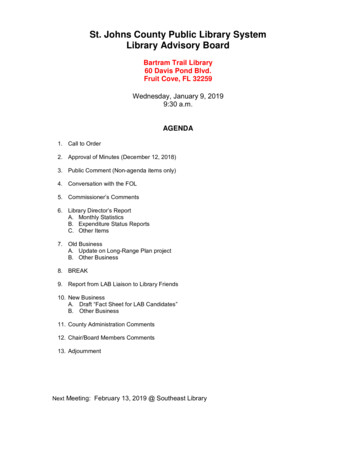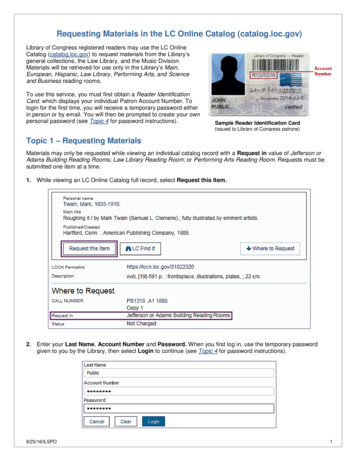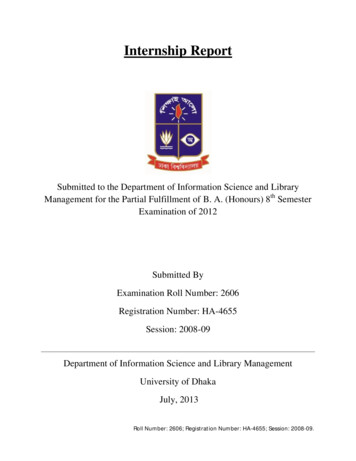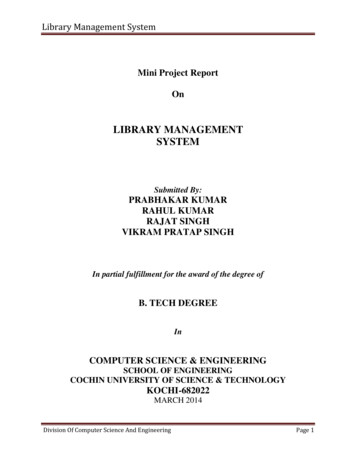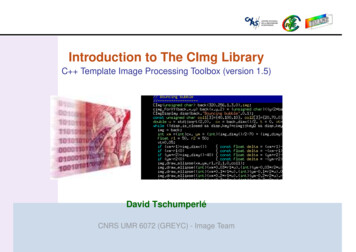
Transcription
Introduction to The CImg LibraryC Template Image Processing Toolbox (version 1.5)David TschumperléCNRS UMR 6072 (GREYC) - Image Team
This document is distributed under the CC-BY-NC-SA license Document available at : http:// img.sour eforge.net/CImg slides.pdf
Outline - PART I of II : CImg Library Overview Context : Image Processing with C . Aim and targeted audience. Why considering The CImg Library ? CImg T : A class for image manipulation. Image construction, data access, math operators. Basic image transformations. Drawing things on images. CImgList T : Image collection manipulation. Basic manipulation functions. CImgDisplay : Image display and user interaction. Displaying images in windows.
Outline - PART II of II : More insights Image Filtering : Goal and principle. Convolution - Correlation.Morphomaths - Median Filter.Anisotropic smoothing.Other related functions. Image Loops : Using predefined macros. Simple loops. Neighborhood loops. The plug-in mechanism. Dealing with 3D objects. Shared images.
PART I of II
Outline - PART I of II : CImg Library Overview Context : Image Processing with C . Aim and targeted audience. Why considering The CImg Library ? CImg T : A class for image manipulation. Image construction, data access, math operators. Basic image transformations. Drawing things on images. CImgList T : Image collection manipulation. Basic manipulation functions. CImgDisplay : Image display and user interaction. Displaying images in windows.
Outline - PART I of II : CImg Library Overview Context : Image Processing with C . Aim and targeted audience. Why considering The CImg Library ? CImg T : A class for image manipulation. Image construction, data access, math operators. Basic image transformations. Drawing things on images. CImgList T : Image collection manipulation. Basic manipulation functions. CImgDisplay : Image display and user interaction. Displaying images in windows.
Context Digital Images. On a computer, image data stored as a discrete array of values (pixels or voxels).
Context Acquired digital images have a lot of different types :– Domain dimensions : 2D (static image), 2D t (image sequence), 3D(volumetric image), 3D t (sequence of volumetric images), .
Context Acquired digital images have a lot of different types :– Domain dimensions : 2D (static image), 2D t (image sequence), 3D(volumetric image), 3D t (sequence of volumetric images), .– Pixel dimensions : Pixels can be scalars, colors, N D vectors, matrices, .
Context Acquired digital images have a lot of different types :– Domain dimensions : 2D (static image), 2D t (image sequence), 3D(volumetric image), 3D t (sequence of volumetric images), .– Pixel dimensions : Pixels can be scalars, colors, N D vectors, matrices, .– Pixel data range : depends on the sensors used for acquisition, can be N-bits(usually 8,16,24,32.), sometimes float-valued.
Context Acquired digital images have a lot of different types :– Domain dimensions : 2D (static image), 2D t (image sequence), 3D(volumetric image), 3D t (sequence of volumetric images), .– Pixel dimensions : Pixels can be scalars, colors, N D vectors, matrices, .– Pixel data range : depends on the sensors used for acquisition, can be N-bits(usually 8,16,24,32.), sometimes float-valued.– Type of sensor grid : Rectangular, Octagonal, .
Context Acquired digital images have a lot of different types :– Domain dimensions : 2D (static image), 2D t (image sequence), 3D(volumetric image), 3D t (sequence of volumetric images), .– Pixel dimensions : Pixels can be scalars, colors, N D vectors, matrices, .– Pixel data range : depends on the sensors used for acquisition, can be N-bits(usually 8,16,24,32.), sometimes float-valued.– Type of sensor grid : Rectangular, Octagonal, . All these different image types are digitally stored using different file formats :– PNG, JPEG, BMP, TIFF, TGA, DICOM, ANALYZE, .
Context(a) I1 : W H [0, 255]3(b) I2 : W H D [0, 65535]32(c) I3 : W H T [0, 4095] I1 : classical RGB color image (digital photograph, scanner, .) (8 bits) I2 : DT-MRI volumetric image with 32 magnetic field directions (16 bits) I3 : Sequence of echography images (12 or 16 bits).
Context Image Processing and Computer Vision aim at the elaboration of numericalalgorithms able to automatically extract features from images, interpret them andthen take decisions. Conversion of a pixel array to a semantic description of the image.- Is there any white pixel in this image ?- Is there any contour in this image ?- Is there any object ?- Where’s the car ?- Is there anybody driving the car ?
ContextSome observations about Image Processing and Computer Vision : They are huge and active research fields. The final goal is almost impossible to achieve ! There have been thousands (millions?) of algorithms proposed in this field, mostof them relying on strong mathematical modeling. The community is varied and not only composed of very talented programmers. How to design a reasonable and useable programming library for such people ?
Observation Most of advanced image processing techniques are “type independent”. Ex : Binarization of an image I : Ω Γ by a threshold ǫ R.I : Ω {0, 1}such that p Ω,I1 : Ω R2 [0, 255] I(p)(01if kI(p)k ǫif kI(p)k ǫI2 : Ω R3 R
Context Implementing an image processing algorithm should be as independent aspossible on the image format and coding. Generic Image Processing Libraries :(.), FreeImage, Devil, (.), OpenCV, Pandore, CImg, Vigra, GIL, Olena, (.) C is a “good” programming language for solving such a problem :- Genericity is possible, quite elegant and flexible (template mechanism).- Compiled code. Fast executables (good for time-consuming algorithms).- Portable , huge base of existing code. Danger : Too much genericity may lead to unreadable code.
Too much genericity. (Example 1).
Too much genericity. (Example 2). Strictly speaking, this is more C stuffs (problems?) than image processing. Definitely not suitable for non computer geeks !!
The CImg Library An open-source C library aiming to simplify the development of imageprocessing algorithms for generic (enough) datasets (CeCILL License).
The CImg Library An open-source C library aiming to simplify the development of imageprocessing algorithms for generic (enough) datasets (CeCILL License). Primary audience : Students and researchers working in Computer Vision andImage Processing labs, and having standard notions of C .
The CImg Library An open-source C library aiming to simplify the development of imageprocessing algorithms for generic (enough) datasets (CeCILL License). Primary audience : Students and researchers working in Computer Vision andImage Processing labs, and having standard notions of C . It defines a set of C classes able to manipulate and process image objects.
The CImg Library An open-source C library aiming to simplify the development of imageprocessing algorithms for generic (enough) datasets (CeCILL License). Primary audience : Students and researchers working in Computer Vision andImage Processing labs, and having standard notions of C . It defines a set of C classes able to manipulate and process image objects. Started in late 1999, the project is now hosted on Sourceforge since December2003 :http:// img.sour eforge.net/
Outline - PART I of II : CImg Library Overview Context : Image Processing with C . Aim and targeted audience. Why considering The CImg Library ? CImg T : A class for image manipulation. Image construction, data access, math operators. Basic image transformations. Drawing things on images. CImgList T : Image collection manipulation. Basic manipulation functions. CImgDisplay : Image display and user interaction. Displaying images in windows.
Main characteristicsCImg is lightweight : Total size of the full CImg (.zip) package : approx. 12.5 Mb.
Main characteristicsCImg is lightweight : Total size of the full CImg (.zip) package : approx. 12.5 Mb. All the library is contained in a single header file CImg.h, that must be included inyour C source :#in lude CImg.h // Just do that.using namespa e img library; // .and you an play with the library
Main characteristicsCImg is lightweight : Total size of the full CImg (.zip) package : approx. 12.5 Mb. All the library is contained in a single header file CImg.h, that must be included inyour C source :#in lude CImg.h // Just do that.using namespa e img library; // .and you an play with the library The library itself only takes 2.2Mb of sources (approximately 45000 lines). The library package contains the file CImg.h as well as documentation, examplesof use, and additional plug-ins.
Main characteristicsCImg is lightweight : What ? a library defined in a single header file ?– Simplicity “a la STL”.
Main characteristicsCImg is lightweight : What ? a library defined in a single header file ?– Simplicity “a la STL”.– Used template functions and structures know their type only during thecompilation phase : No relevance in having pre-compiled objects (.cpp .o).
Main characteristicsCImg is lightweight : What ? a library defined in a single header file ?– Simplicity “a la STL”.– Used template functions and structures know their type only during thecompilation phase : No relevance in having pre-compiled objects (.cpp .o).– Why not several headers (one for each class) ? Interdependence of the classes : all headers would be always necessary.
Main characteristicsCImg is lightweight : What ? a library defined in a single header file ?– Simplicity “a la STL”.– Used template functions and structures know their type only during thecompilation phase : No relevance in having pre-compiled objects (.cpp .o).– Why not several headers (one for each class) ? Interdependence of the classes : all headers would be always necessary.– Only used functions are actually compiled : Small generated executables.
Main characteristicsCImg is lightweight : What ? a library defined in a single header file ?– Simplicity “a la STL”.– Used template functions and structures know their type only during thecompilation phase : No relevance in having pre-compiled objects (.cpp .o).– Why not several headers (one for each class) ? Interdependence of the classes.– Only used functions are actually compiled : Small generated executables. Drawback : Compilation time and needed memory important when optimizationflags are set.
Main characteristicsCImg is (sufficiently) generic : CImg implements static genericity by using the C template mechanism. One template parameter only : the type of the image pixel.
Main characteristicsCImg is (sufficiently) generic : CImg implements static genericity by using the C template mechanism. One template parameter only : the type of the image pixel. CImg defines an image class that can handle hyperspectral volumetric (i.e 4D)images of generic pixel types.
Main characteristicsCImg is (sufficiently) generic : CImg implements static genericity by using the C template mechanism. One template parameter only : the type of the image pixel. CImg defines an image class that can handle hyperspectral volumetric (i.e 4D)images of generic pixel types. CImg defines an image list class that can handle temporal image sequences.
Main characteristicsCImg is (sufficiently) generic : CImg implements static genericity by using the C template mechanism. One template parameter only : the type of the image pixel. CImg defines an image class that can handle hyperspectral volumetric (i.e 4D)images of generic pixel types. CImg defines an image list class that can handle temporal image sequences. . But, CImg is limited to images having a rectangular grid, and cannot handleimages having more than 4 dimensions.
Main characteristicsCImg is (sufficiently) generic : CImg implements static genericity by using the C template mechanism. One template parameter only : the type of the image pixel. CImg defines an image class that can handle hyperspectral volumetric (i.e 4D)images of generic pixel types. CImg defines an image list class that can handle temporal image sequences. . But, CImg is limited to images having a rectangular grid, and cannot handleimages having more than 4 dimensions. CImg covers actually 99% of the image types found in real world applications.
Main characteristicsCImg is multi-platform : It does not depend on many libraries.It can be compiled only with existing system libraries.
Main characteristicsCImg is multi-platform : It does not depend on many libraries.It can be compiled only with existing system libraries. Advanced tools or libraries may be used by CImg (ImageMagick, XMedcon, libpng,libjpeg, libtiff, libfftw3.), these tools being freely available for any platform.
Main characteristicsCImg is multi-platform : It does not depend on many libraries.It can be compiled only with existing system libraries. Advanced tools or libraries may be used by CImg (ImageMagick, XMedcon, libpng,libjpeg, libtiff, libfftw3.), these tools being freely available for any platform. Successfully tested platforms : Win32, Linux, Solaris, *BSD, Mac OS X. It is also “multi-compiler” : g , Visual Studio .NET, Intel ICL, Clang .
Main characteristicsAnd most of all, . CImg is very simple to use : Only 1 single file to include.
Main characteristicsAnd most of all, . CImg is very simple to use : Only 1 single file to include. Only 4 C classes to know :CImg T , CImgList T , CImgDisplay, CImgEx eption.
Main characteristicsAnd most of all, . CImg is very simple to use : Only 1 single file to include. Only 4 C classes to know :CImg T , CImgList T , CImgDisplay, CImgEx eption. Very basic low-level architecture, simple to apprehend (and to hack if necessary!).
Main characteristicsAnd most of all, . CImg is very simple to use : Only 1 single file to include. Only 4 C classes to know :CImg T , CImgList T , CImgDisplay, CImgEx eption. Very basic low-level architecture, simple to apprehend (and to hack if necessary!). Enough genericity and library functions, allowing complex image processing tasks.
Main characteristicsAnd most of all, . CImg is very simple to use : Only 1 single file to include. Only 4 C classes to know :CImg T , CImgList T , CImgDisplay, CImgEx eption. Very basic low-level architecture, simple to apprehend (and to hack if necessary!). Enough genericity and library functions, allowing complex image processing tasks. and extensible : Simple plug-in mechanism to easily add your own functions to the library core(without modifying the file CImg.h of course).
Hello World step by step#in lude "CImg.h"using namespa e img library;int main(int arg , har **argv) {return 0;}
Hello World step by step#in lude "CImg.h"using namespa e img library;int main(int arg , har **argv) {CImg unsigned har img(300,200,1,3);return 0;}
Hello World step by step#in lude "CImg.h"using namespa e img library;int main(int arg , har **argv) {CImg unsigned har img(300,200,1,3);img.fill(32);return 0;}
Hello World step by step#in lude "CImg.h"using namespa e img library;int main(int arg , har **argv) {CImg unsigned har n 0;}
Hello World step by step#in lude "CImg.h"using namespa e img library;int main(int arg , har **argv) {CImg unsigned har lur(2,0,0);return 0;}
Hello World step by step#in lude "CImg.h"using namespa e img library;int main(int arg , har **argv) {CImg unsigned har lur(2,0,0);onst unsigned har white[ { 255,255,255 };img.draw text(80,80,"Hello World",white,0,32);return 0;}
Hello World step by step#in lude "CImg.h"using namespa e img library;int main(int arg , har **argv) {CImg unsigned har lur(2,0,0);onst unsigned har white[ { 255,255,255 };img.draw text(80,80,"Hello World",white,0,32);img.display();return 0;}
Hello World step by step
Hello World step by step : animated#in lude "CImg.h"using namespa eimg library;int main(int arg , har **argv) {onst CImg unsignedCImg unsignedhar img har (300,200,1,3).fill(32).noise(128).blur(2,0,0).draw text(80,80,"Hello World",CImg unsignedhar ::ve tor(255,255,255).ptr(),0,32);CImgDisplay disp(img,"Moving Hello World",0);for (float t 0; !disp.is losed(); t 0.04) {CImg unsignedhar res(img);img forYC(res,y,v)res.get shared row(y,0,v).shift((int)(40*std::sin(t y/50.0)),0,0,0,2);disp.display(res).wait(20);if (disp.is resized()) disp.resize();}return 0;}
Another example : Computing gradient norm of a 3D volumetric image Let I : Ω R3 R, compute p Ω,k Ik(p) s I x 2 I y 2 I z 2 Code :#in lude CImg.h''using namespa eimg library;int main(int arg , har **argv) {onst CImg float img( brain irm3d.hdr'');onst CImgList float grad img.get gradient( xyz'');CImg float norm (grad[0 .pow(2) grad[1 .pow(2) grad[2 .pow(2));norm.sqrt().get normalize(0,255).save( brain gradient3d.hdr'');return 0;}
Another example : Computing gradient norm of a 3D volumetric image
Live Demo ! Let see what we can do with this library.
Overall Library Structure The whole library classes and functions are defined in thenamespace.img library::
Overall Library Structure The whole library classes and functions are defined in thenamespace. The library is composed of only four C classes :– CImg T , represents an image with pixels of type T.img library::
Overall Library Structure The whole library classes and functions are defined in thenamespace. The library is composed of only four C classes :– CImg T , represents an image with pixels of type T.– CImgList T , represents a list of images CImg T .img library::
Overall Library Structure The whole library classes and functions are defined in thenamespace. The library is composed of only four C classes :– CImg T , represents an image with pixels of type T.– CImgList T , represents a list of images CImg T .– CImgDisplay, represents a display window.img library::
Overall Library Structure The whole library classes and functions are defined in thenamespace. The library is composed of only four C classes :––––CImg T , represents an image with pixels of type T.CImgList T , represents a list of images CImg T .CImgDisplay, represents a display window.CImgException, used to throw library exceptions.img library::
Overall Library Structure The whole library classes and functions are defined in thenamespace.img library:: The library is composed of only four C classes :––––CImg T , represents an image with pixels of type T.CImgList T , represents a list of images CImg T .CImgDisplay, represents a display window.CImgException, used to throw library exceptions. A sub-namespace img library:: img:: defines some low-level library functions(including some useful ones asrand(), grand(), min T (), max T (), abs T (), sleep(), etc.).
Overall Library Structurecimg library::cimg::Low level functionsCImg T ImageCImgExceptionError handlingCImgList T Image ListCImgDisplayDisplay Window
CImg methods All CImg classes incorporate two different kinds of methods :– Methods which act directly on the instance object and modify it. These methodsreturns a reference to the current instance, so that writting function pipelines ispossible :CImg ( toto.jpg'').blur(2).mirror('y').rotate(45).save( tutu.jpg'');
CImg methods All CImg classes incorporate two different kinds of methods :– Methods which act directly on the instance object and modify it. These methodsreturns a reference to the current instance, so that writting function pipelines ispossible :CImg ( toto.jpg'').blur(2).mirror('y').rotate(45).save( tutu.jpg'');– Other methods return a modified copy of the instance. These methods startwith get *() :CImg img( toto.jpg'');CImg img2 img.get blur(2);// 'img' is not modifiedCImg img3 img.get rotate(20).blur(3); // 'img' is not modified
CImg methods All CImg classes incorporate two different kinds of methods :– Methods which act directly on the instance object and modify it. These methodsreturns a reference to the current instance, so that writting function pipelines ispossible :CImg ( toto.jpg'').blur(2).mirror('y').rotate(45).save( tutu.jpg'');– Other methods return a modified copy of the instance. These methods startwith get *() :CImg img( toto.jpg'');CImg img2 img.get blur(2);// 'img' is not modifiedCImg img3 img.get rotate(20).blur(3); // 'img' is not modified Almost all CImg methods are declined into these two versions.
Outline - PART I of II : CImg Library Overview Context : Image Processing with C . Aim and targeted audience. Why considering The CImg Library ? CImg T : A class for image manipulation. Image construction, data access, math operators. Basic image transformations. Drawing things on images. CImgList T : Image collection manipulation. Basic manipulation functions. CImgDisplay : Image display and user interaction. Displaying images in windows.
CImg T : Overview This is the main class of the CImg Library. It has a single template parameter T. A CImg T represents an image with pixels of type T (default template parameteris T float). Supported types are the C/C basic types : bool, unsigned har,har, unsigned short, short, unsigned int, int, float, double, .
CImg T : Overview This is the main class of the CImg Library. It has a single template parameter T. A CImg T represents an image with pixels of type T (default template parameteris T float). Supported types are the C/C basic types : bool, unsigned har,har, unsigned short, short, unsigned int, int, float, double, . An image has always 3 spatial dimensions (width, height,depth) 1 hyperspectraldimension (dim) : It can represent any data from a scalar 1D signal to a 3D volumeof vector-valued pixels.
CImg T : Overview This is the main class of the CImg Library. It has a single template parameter T. A CImg T represents an image with pixels of type T (default template parameteris T float). Supported types are the C/C basic types : bool, unsigned har,har, unsigned short, short, unsigned int, int, float, double, . An image has always 3 spatial dimensions (width, height,depth) 1 hyperspectraldimension (dim) : It can represent any data from a scalar 1D signal to a 3D volumeof vector-valued pixels. Image processing algorithms are methods of CImg T ( 6 STL ) :blur(), resize(), onvolve(), erode(), load(), save(). Method implementation aims to handle the most general case (3D volumetrichyperspectral images).
CImg T : Low-level Architecture (for hackers!) The structure CImg T is defined as :template typename T stru t CImg {unsigned int width;unsigned int height;unsigned int depth;unsigned int dim;bool is shared;T* data;};
CImg T : Low-level Architecture (for hackers!) The structure CImg T is defined as :template typename T stru t CImg {unsigned int width;unsigned int height;unsigned int depth;unsigned int dim;bool is shared;T* data;}; A CImg T image is always entirely stored in memory. A CImg T is independent : it has its own pixel buffer.
CImg T : Low-level Architecture (for hackers!) The structure CImg T is defined as :template typename T stru t CImg {unsigned int width;unsigned int height;unsigned int depth;unsigned int dim;bool is shared;T* data;}; A CImg T image is always entirely stored in memory. A CImg T is independent : it has its own pixel buffer most of the time. CImg member functions (destructor, constructors, operators,.) handle memoryallocation/desallocation efficiently.
CImg T : Memory layout (for hackers!)template typename T stru t CImg {unsigned int width;unsigned int height;unsigned int depth;unsigned int dim;bool is shared;T* data;}; Pixel values are not stored in a typical “RGBRGBRGBRGBRGB” order. Pixel values are stored first along the X-axis, then the Y-axis, then the Z-axis, thenthe C-axis :R(0,0) R(1,0) . R(W-1,0) . R(0,1) R(1,1) . R(W-1,1) . R(0,H-1) R(1,H-1). R(W-1,H-1) . G(0,0) . G(W-1,H-1) . B(0,0) . B(W-1,H-1).
Outline - PART I of II : CImg Library Overview Context : Image Processing with C . Aim and targeted audience. Why considering The CImg Library ? CImg T : A class for image manipulation. Image construction, data access, math operators. Basic image transformations. Drawing things on images. CImgList T : Image collection manipulation. Basic manipulation functions. CImgDisplay : Image display and user interaction. Displaying images in windows.
CImg T : Constructors (1) Default constructor, constructs an empty image.CImg T (); No memory allocated in this case, images dimensions are zero. Useful to declare an image without allocating its pixel values.#in lude CImg.h''using namespa e img library;int main() {CImg unsigned har img 8bits;CImg unsigned short img 16bits;CImg float img float;return 0;}
CImg T : Constructors (2) Constructs a 4D image with specified dimensions. Omitted dimensions are setto 1 (default parameter).CImg T (unsigned int, unsigned int, unsigned int, unsigned int);#in lude CImg.h''using namespa eimg library;int main() {CImg float img(100,100);CImg unsigned// 2D s alar image.har img2(256,256,1,3);CImg bool img3(128,128,128);// 2D olor image.// 3D s alar image.CImg short img4(64,64,32,16); // 3D hyperspe tral image (16 bands).return 0;} No initialization of pixel values is performed. Can be done with :CImg T (unsigned int, unsigned int, unsigned int, unsigned int, onst T&);
CImg T : Constructors (3) Create an image by reading an image from the disk (format deduced by thefilename extension).CImg T ( onst har *filename);#in lude CImg.h''using namespa e img library;int main() {CImg unsigned har img( nounours.jpg'');CImg unsigned short img2( toto.png'');CImg float img3( toto.png'');return 0;} Pixel data of the file format are converted (static cast) to the specified templateparameter.
CImg T : In-place constructors CImg T & assign(.)Each constructor has an in-place version with same parameters.CImg float img;img.assign( ; This principle is extended to the other CImg classes.CImgList float list;list.assign(img1,img2,img3);CImgDisplay disp;disp.assign(list,''List display'');
CImg T : Access to image data informations Get the dimension along the X,Y,Z or C-axis (width, height, depth or channels).int width() onst;int W img.width(), H img.height(), D img.depth(), S img.spe trum();
CImg T : Access to image data informations Get the dimension along the X,Y,Z or C-axis (width, height, depth or channels).int width() onst;int W img.width(), H img.height(), D img.depth(), S img.spe trum(); Get the pixel value at specified coordinates. Omited coordinates are set to 0.T& operator()(unsigned int, unsigned int, unsigned int, unsigned int);unsigned har R img(x,y), G img(x,y,0,1), B img(x,y,2);float val volume(x,y,z,v);img(x,y,z) x*y;(Out-of-bounds coordinates are not checked !)
CImg T : Access to image data informations Get the dimension along the X,Y,Z or C-axis (Width, Height, Depth or Channels).int width() onst;int W img.width(), H img.height(), D img.depth(), S img.spe trum(); Get the pixel value at specified coordinates. Omited coordinates are set to 0.T& operator()(unsigned int, unsigned int, unsigned int, unsigned int);unsigned har R img(x,y), G img(x,y,0,1), B img(x,y,2);float val volume(x,y,z,v);img(x,y,z) x*y;(Out-of-bounds coordinates are not checked !) Get the pixel value at specified sub-pixel position, using bicubic interpolation. Outof-bounds coordinates are checked.float ubi pix2d(float, float, unsigned int, unsigned int);float val img.get ubi pix2d(x-0.5f,y-0.5f);
CImg T : Copies and assignments Construct an image by copy. Perform static pixel type cast if needed.template typename t CImg T ( onst CImg t & img);CImg float img float(img double);
CImg T : Copies and assignments Construct an image by copy. Perform static pixel type cast if needed.template typename t CImg T ( onst CImg t & img);CImg float img float(img double); Assignement operator. Replace the instance image by a copy of img.template typename t CImg T & operator ( onst CImg t & img);CImg float img;CImg unsigned har img2( toto.jpg''), img3(256,256);img img2;img img3; Modifying a copy does not modify the original image (own pixel buffer).
CImg T : Math operators and functions Most of the usual math operators are defined : ,-,*,/, ,- ,.CImg float img( toto.jpg''), dest;dest (2*img 5);dest img;
CImg T : Math operators and functions Most of the usual math operators are defined : ,-,*,/, ,- ,.CImg float img( toto.jpg''), dest;dest (2*img 5);dest img; Operators always try to return images with the best datatype.CImg unsigned har img( toto.jpg'');CImg float dest;dest img*0.1f;img* 0.1f;
CImg T : Math operators and functions Most of the usual math operators are defined : ,-,*,/, ,- ,.CImg float img( toto.jpg''), dest;dest (2*img 5);dest img; Operators always try to return images with the best datatype.CImg unsigned har img( toto.jpg'');CImg float dest;dest img*0.1f;img* 0.1f; Usual math functions are also defined : sqrt(), os(), pow().img.pow(2.5);res img.get pow(2.5);res img.get os().pow(2.5);
Outline - PART I of II : CImg Library Overview Context : Image Processing with C . Aim and targeted audience. Why considering The CImg Library ? CImg T : A class for image manipulation. Image construction, data access, math operators. Basic image transformations. Drawing things on images. CImgList T : Image collection manipulation.


